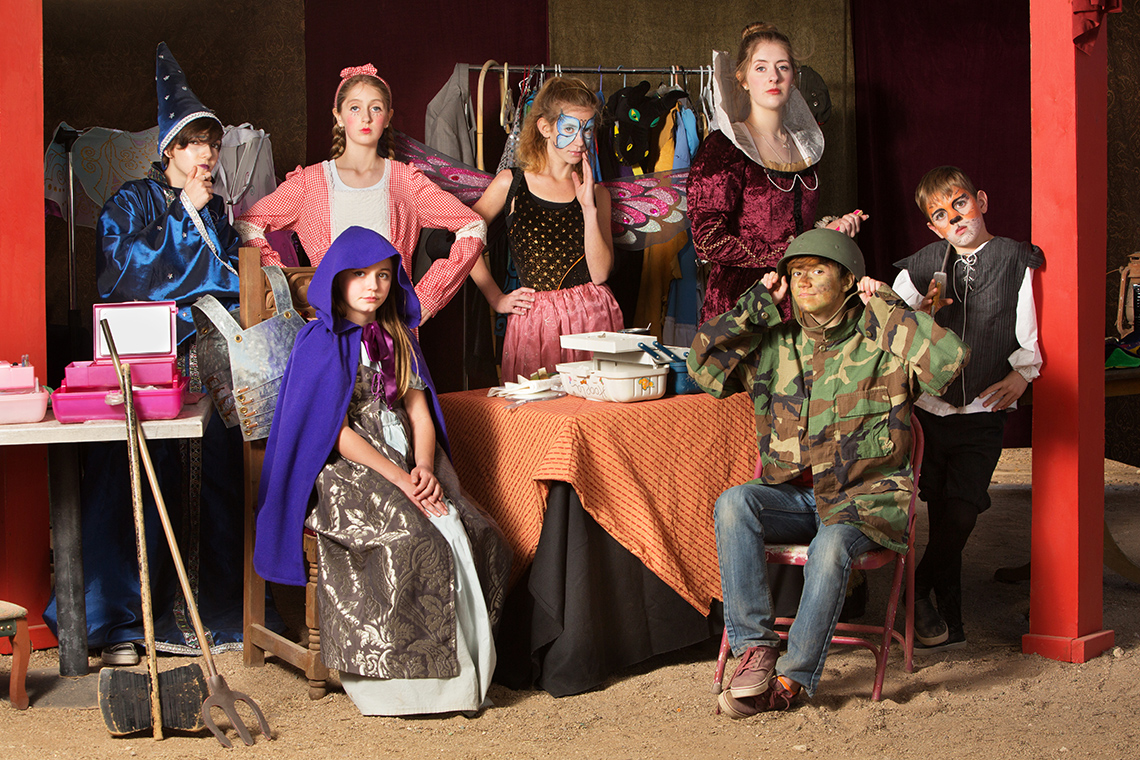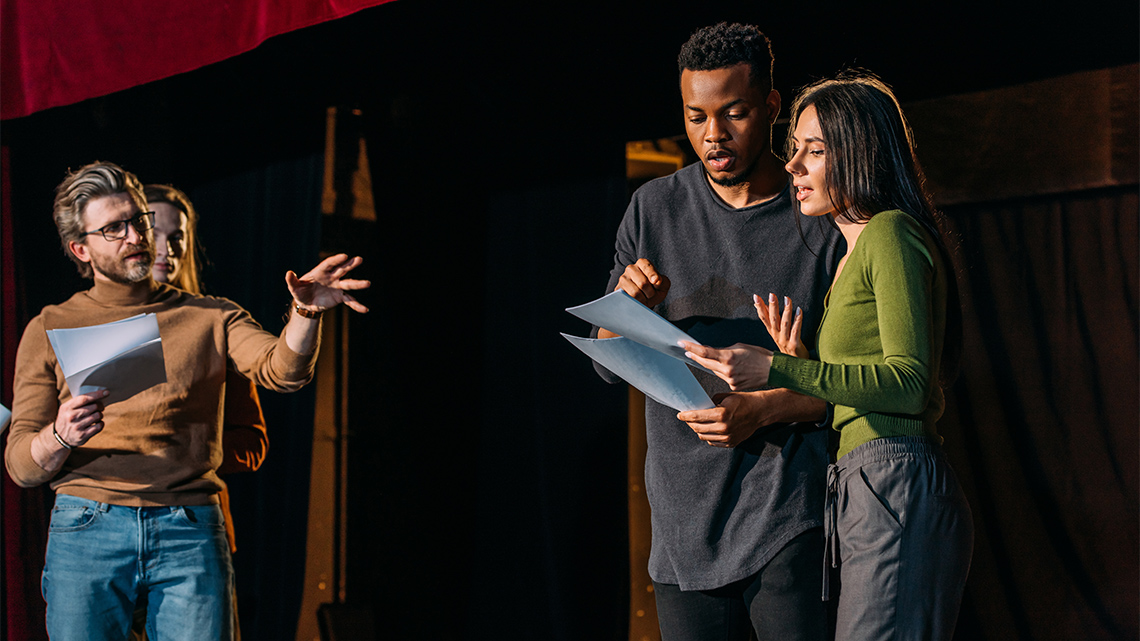Minds On
Warm up
Before you begin, don't forget to do your safety check!
Warm Up
Breathing exercise

We are going to begin with a breathing activity.
Find a comfortable position. Focus your attention on one part of the body at a time.
How does that part of your body feel? If possible, take a deep breath and allow your lungs to expand.
Focus your attention on one part of your body. Allow that part to relax before moving on to the next. As you scan through your body, keep breathing deeply. Once you have completed the scan, take a moment to stretch.
If you wish, you can access this recording entitled “Deep Breathing” to complete your breathing activity.
Deep Breathing
Drama game
Explore this video entitled “Follow the Leader” to play a game. In this video, one actor is leading, and one actor is following. They explore different movements and facial expressions together. Try following the actors and create your own actions.
You might try this game with a partner or small group and create your own environments. To end the game, either of you can use the words “end scene.”
Let's get started
Student Success
Getting ready for the show
Explore the carousel below. What is happening in each image?
Notice that all these individuals are working in a common space. Where do you think this might be?
Record your ideas using a method of your choice.
Share your thoughts with a partner, if possible.
Note to teachers: See your teacher guide for collaboration tools, ideas and suggestions.
Action
Get ready, get set…
Who is part of a theatre?

You may have guessed that all the individuals in the Minds On section work in a theatre.
Explore the following information to learn more about each member of the crew. These are only a few of examples of the crew members that make up a theatre company.
Press the following tabs to access each crew member and what they do.
Artistic directors:
- read and select scripts for new shows
- hire a variety of staff members to work in the theatre company. This might include: directors, actors, stage managers, light designers, sound designers, etc.
- discuss the budget of the theatre and funding with the Executive Director
- direct shows
- represent the theatre at different events in the community
- think about how the overall direction and vision of the theatre company
Title - "Playwright"
Body Text - "Playwright:
- create plays: research, gather information, write drafts, create a final version
- create a synopsis and character list
- researching and gathering data
- work with publishers, directors, and producers
- revising and editing the play if necessary"
Lighting designers:
- design the lighting needed for the performance
- understand health and safety procedures
- add notes to the scripts to show where lighting will change
- participate in rehearsals
Scenic designers:
- brainstorm design ideas
- build scale models of sets
- research to make sure that the set design fits with the setting of the play (e.g., historical time period, theme, etc.)
- create the set within the budget provided
Sound designers:
- create a variety of sound effects to enhance the drama performance
- select, edit, and remix music
- work with a composer to create an original soundtrack or work with live musicians to create music to accompany the performance
- help to make sure the sound is accessible to the audience: testing the acoustics of a theatre, configuration of radio and float mics for the performers
Costume designers:
- review the script and make notes on areas where costumes are required
- research the time period and setting of the play
- research the fashion in different time periods and places
- design costumes for each character in the production
- work together with the director to understand the theme and focus of the production
Actors:
- review the script and make notes about their character
- recognize relationships that exist between their character and other characters and work with other actors
- work with a director, choreographer, set designer, and other members of the crew to develop their role in the production
Go!
Crew member

Imagine you are a member of a theatre company, which makes you a part of the crew on a drama production. You are going to describe a day at the theatre. In order to prepare for this, let's start with you out of role to do some research.
Out of role
Explore the following videos below for ideas from real members of theatre companies. Record any information that you feel might help you prepare for your character, using a method of your choice.
Press the following tabs to access these videos for each crew member’s role.
What do you notice about the models in this video?
How did this scenic designer decide to go into this profession?
Access this video entitled “Working in The Theatre: Scenic Design” to learn more about the role of scenic designers.
What is the difference between costume design and wardrobe in a theatre production?
A costume designer works on a production from the beginning. They have researched the characters and setting, and have chosen designs for specific reasons (e.g. historical design which uses specific fabrics and colours).
A wardrobe supervisor works with the actors on the production, does fittings, and helps make sure everyone is comfortable as they move forward with the production
Access this video entitled “Working in the Theatre: Wardrobe” to learn more about who is in charge of costumes and wardrobes.
What is the specialty prop the designer is working on in this video?
Candle carts for the musical Hamilton. The team has to replace the inside electronic lights for 109 candles.
What kind of specialty prop would you want to work on?
Access this video entitled “Working in the Theatre: Specialty Props” to learn about how props are made!
What is the role of a lighting designer in a production?
Access this video entitled “Working in the Theatre: Lighting Design” to learn more about the role of a lighting designer.
A lighting designer is using a set of lights to frame the stage and help the audience understand what is happening in the production. A lighting designer can help to create setting and mood.
How does the director guide the actors on stage?
Access this video entitled “Blocking and Stage Directions” to learn more about the role of a director.
What are some of the ways an actor can get into role when they are learning a new character?
Access this video entitled “Acting Out a Character” to learn more about the role of an actor.
In role
Now, imagine yourself in the role of your choice. Consider the following questions:
- What would you do on a normal day at the theatre?
- Who do you work with?
- What do you need to complete your work?
You may record your ideas using a method of your choice.
Consolidation
Putting it all together
A day in the life

Using your notes from the Action section, use one of the following drama conventions to create a day in the life of your character in a theatre company.
You can also record your ideas as a detailed written or audio clip about what you would do for each scenario. Consider adding your work to your drama portfolio.
Tableau
A tableau is a silent, motionless picture. In drama, we can use tableau to express different themes, feelings, and ideas. Tableaux may be presented as stand-alone images to communicate one specific message or may be used in a longer drama work.
Explore this video to learn more about tableaux.
Use a series of tableaux to share different parts of your day in the theatre company.
Monologue
A monologue is long speech by one character in a drama. It is meant for the character to share their thoughts and feelings with the audience.
Explore this video to learn more monologues.
Create a five- to seven-line monologue that describes your role in the theatre company.
You may use the Monologue Diary in your notebook or using the following fillable and printable document to record your monologue. If you would like, you can use speech-to-text or audio recording tools to record your thoughts. Consider adding your work to your drama portfolio.
|
My Day at the Theatre |
Press the ‘Activity’ button to access Monologue Diary.
Narration
Narration is a convention where the speaker describes the action that is happening in a drama story or play. Narration can be used to describe the action through a third-person narrator that is not a character in the drama story or play.
Explore this example narration audio clip for “The Wasps, the Bees and the Hornet.”
The Wasps, the Bees and the Hornet
Create a description of an exciting part of your day at the theatre company.
Pause and Reflect
Pause and reflect
In creating a day in the life of your character, what did you learn about working at a theatre company?
Do you have any questions for any specific crew members?
Reflection
As you read through these descriptions, which sentence best describes how you are feeling about your understanding of this learning activity? Press the button that is beside this sentence.
I feel…
Now, record your ideas using a voice recorder, speech-to-text, or writing tool.




